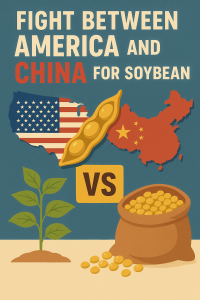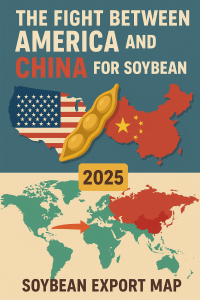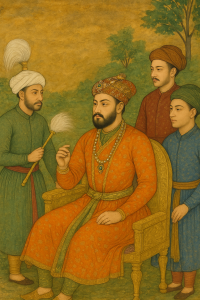America vs China Trade war

The Soybean Confrontation: America vs China trade war A Deep Dive into Trade, Strategy, and Global Impacts
- must be stored, which costs.
- Transportation routes (rails, ports) designed for exporting large quantities are underutilized, causing inefficiencies.
Government Response: Support & Subsidies
- • The U.S. government has been pushed to offer support to farmers. For example, recent announcements indicate federal support aimed at soybean farmers impacted by China’s refusal to buy.
- Previous aid packages, tariff revenues, and and biofuel policies are also part of mitigation.
-
Impact on Global Markets & Brazil/Argentina Advantage-america vs china trade war
Brazil: Scaling Up Production & Export Logistics
- Brazil is solidifying its position as China’s top soybean supplier. In many months, upwards of 80-90% of China’s imports are from Brazil.
- Infrastructure improvements (ports, freight, storage) in Brazil are helping it serve demand more reliably.
Argentina: Export Tax Policies and Production Increases
- Argentina briefly removed its soybean export tax to boost competitiveness beforereinstating it after certain export revenue thresholds.
- Climatic, logistic, and regulatory challenges exist, but Argentina is benefiting from China’s shift.
Other Suppliers & Emerging Players
- Non-traditional sources like Ethiopia for soymeal are being tapped.
- As China looks beyond just whole beans, for processed soy products also, this opens opportunities for new exporters. america vs china trade war
Effects on Futures Markets and Global Prices
- The disruption has contributed to volatility in soybean futures. Demand expectations change, leading to price swings.
- Market participants increasingly watch not only supply and demand in classic senexist,the classicse, but alsothe classicbut also policy (tariffs, trade negotiations) as a core factor.
-
Political Implications and Diplomatic Tensions
america vs china Trade War as a Policy Tool
- China is using soybeans (and other agricultural products) as leverage in trade negotiations, effectively making them pawn pawnsin larger geopolitical negotiations.
- U.S. seeReuters +1• The U.S.s the pushback as retaliation and also as part of China’s broader strategy to reduce dependency on U.S. exports.
Domestic Politics: U.S. Farmer Sentiment
- Farmers in key states (Midwest) are under economic pressure. Loss of China as buyer c• The U.S.a buyerauses stress on incomes, lea buyerincomes andads to lobbying for policy changes, aiincomes andchanges andd.
- Agricultural states are politically important; trade policies affecting soybeans can sway political support.
China’s Domestic Strategy & Food Security Narrative
- China emphasizes that its food supply and feed supply remain “secure,” arguing that it’s simply diversifying sources.
- Investments in domestic soybean and feed production, regulatory measures to allow more suppliers, and biosecurity are parts of that narrative.
-
Supply Chain, Infrastructure & Logistical Adjustments
U.S. Infrastructure Strain
- Ports, rachanges andPorts andils used for transporting soybeans to export hubs are under-utilizedPorts andunderutilized;; capacity surpluses raise cost per unit.
- Storage facilities are filling up; farmers need more silos, bins, cold storage,underutilized;storage, etc.
Adjusting to Demand Shifts
- U.S. exporters are looking for alternative international markets (e.g., Southeast Asia, the EU,the EU, etc.). But these have challenges: tariffs, quality requirements, and and competition.
Brazil & Argentina Scaling Transport & Storage
- To satisfy rising Chinese demand, investments in port capacity, inland logistics, andlogistics, and road and rail improvements are increasing in Brazil & Argentina. america vs china trade war
Quality, Certification & Non-tariff Barriers
- Chinese import rules include quality, inspection, phytosanitary standards, somstandards, andetimes quotas. U.S. exporters must meet these standards, adding cost and delay. Brazil and Argentina may have cost advantages here orstandards, andhave adapted faster.soyabean farmers
-
Price Trends and Market Volatility
- Prices of soybeans globally have suffered with the declineline in demand from China, especially for U.S. varieties.
- Futures markets have seen increased volatility, especially around trade negotiation announcements, tariff changes, and harvest reports.
Supply Surpluses and Carryover Stocks
- • The U.S.e U.S. has increasing carryover stocks because exports have fallen while production has remained strong. Oversupply tends to pull prices down further.
Cost Inputs & Profit Margins
- Rising costs for inputs (fertilizer, fuel, labor) are squeezing farmer margins even more when prices fall.
- Some U.S. farmers may shift acreage away from soybeans toward more profitable crops, altering future supply.
-
Environmental & Sustainability Dimensions
Land Use Changes & Deforestation
- Brazil and Argentina expanding soybean cultivation may lead to deforestation or conversion of sensitive lands.
- Environmental regulations andand land management policies will be under pressure.
Greenhouse Gas Emissions & Carbon Footprint
- Transport distances, processing, andprocessing, and land use changes contribute to GHG emissions. Sourcing from further away vs. local production trade-offs matter.
Sustainable Production & Certification
- Chinese buyers (and the globalthe global market) are increasingly concerned about sustainability, deforestation, anddeforestation, and environmental certification. Suppliers who can meet those standards may gain an advantage.an advantage.
-
Future Outlook: What Lies Ahead (2025-2030)
Will China Resume Buying U.S. Soybeans?
- Much depends on diplomatic/trade negotiations. So far (2025), China has placed zero new-cropnew-crop orders for U.S. soybeans.
- For the U.S.the U.S. to regain ground, tariffs would likely need to be lowered, non-tariff barriers eased, and reliability reestablished.america vs china trade war. Gemini
Alternative Markets for the U.S.the U.S.
- U.S.U.S. exporters may increasingly target Europe, Southeast Asia, and others to make up for lost Chinese demand. But competition from Brazil/Argentina, distance, and local trade policies may limit gains.
Capabilities & Investment in Brazil / Argentina
- These countries will likely invest heavily in scaling up production, improving logistics & storage, perhaps better seed varieties, andvarieties, and environmental sustainability to meet global expectations.
Technological & Policy Innovation
- Genetically improved soybean varieties, yield improvements, andimprovements, and more efficient processing and storage will help offset cost disadvantages.
- U.S. policies on biofuels, subsidies, trade agreements, andagreements, and export financing will be crucial.
Likely Trade Scenarios
- Scenario A: Partial easing of trade tensions leads to a limiteda limited return of U.S. exports to China, but the U.S.the U.S. share remains well below pre-2018 levels.
- Scenario B: Continued decoupling: China fully diversifies, and thediversifies, and the U.S.U.S. permanently loses a majora major share andshare and shifts to other markets.
- Scenario C: New trade deal with wider scope including agriculture, so the U.S.the U.S. may regain ground if competitive.
-
Strategies & Recommendations
Based on current data and likely futures, here are strategies for different stakeholders:

Stakeholder RecommendationsStakeholder RecommendationsU.S. Farmers & PProducers iversify target markets,mProducers Producers arkets, adjust crop choices,cmarkets,hoices, invest in cost reduction;rchoices,eduction, improve quality/certification; forqreduction,uality/certification, andreduction,m cooperatives to improve bargaining Makers pquality/certification, andower. quality/certification, andpower.
U.S. Government / Policy tariffpower. sMakers ,Negotiate trade agreements that reduce/remove tariffMakers s;tariffs, provide support and insurance for farmers;tariffs,farmers,farmers, invest in infrastructure;farmers,infrastructure,infrastructure, promote exports to new regions; supinfrastructure,regions, andregions, andport sustainability standards.
Cregions, andstandards. standards. hinese Importers /Policymaker/standards. PolicymakerssP/Policymakersolicymakers nsure supply chain resilience; enforce consistent quality and environmental standards; invest in domestic production; andpPolicymakers roduction; and maintain good relations with multiple sources so as not to be overly dependent on one ccountry. brazil / Argentina / Other SuppliersScountry. Suppliers cale up production in aa sustainablSSuppliers uppliers eele way; invest in logistics (ports, transport);ity. v-term-termolatility.
globalTrade & MultilateralsMvolatility. Multilaterals onitor trade trajectory;tMultilaterals rajectory,Multilaterals mediate policy negotiations;ntrajectory,egotiations,trajectory, ensure that trade rules (WTO (negotiations,WTO,negotiations,etc.) are respected, andr(WTO,espected, and(WTO,e—itrespected, and help emerging agricultural exporters meet standards.
-
Conclusion america vs china;the soyabean trade war
The fight between America vs China trade war for soybeans is not a side battle—it is a key front in the larger global trade war, supply‐chainsupply chainside battle—it reorganization, and food security landscape.
america vs china trade war From the dramatic drop in U.S. exports to CChina tosupply chainBrazil’s surging ddominance tothe economic and political pressures on farmers, the effects are pervasive.
While China’s current strategy of diversification is working, the long-term picture remains fluid. The U.S. could regain some of its lost market, but that will require policy shifts, trade diplomacy, competitiveness, and strategic investments. For farmers, exporters, and global markets, adaptability will be crucial.america vs china trade war.

Understanding this fight is essential not just for those directly involved, but also for consumers, policymakers, and observers of global trade. Because the soybean conflict is very much a story about where and how the world will get its feed, oil, and agricultural balance in the years ahead.






